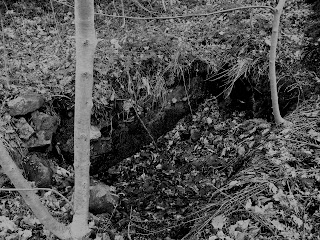 At the crossroad where Amalie Skrams Vei and the lowest part of Formanns Vei meet, there is a cluster of maple trees (Acer platanoides). More precisely, there are three large ones and several smaller ones. Acer Platanoides is not particularly long-lived, with a maximum age of around 250 years.
At the crossroad where Amalie Skrams Vei and the lowest part of Formanns Vei meet, there is a cluster of maple trees (Acer platanoides). More precisely, there are three large ones and several smaller ones. Acer Platanoides is not particularly long-lived, with a maximum age of around 250 years.These particular individuals grow in a 45 degree-angeled hillside covered with dirt and leaves showing signs of use as a local dirt path, passing from the upper living area in Sandviken down to the busy traffic street where you in fact find the access vein into the city centre.
Based on prior observations in the area, we infer that parts of the hut must have been constructed within the last three years, while older parts, including a blue swing rope attached to the southern tree, at least dates back to 1999. This makes it probable that the locality is still in use, not least evidenced by the presence of a red "flag" which not long ago must have been covering a young upper body as a t-shirt.
 The hut itself frugally ascends two of the biggest tree logs, and it is obvious that you must have the ability to be a good climber to master the challenges that this hut has to offer.
The hut itself frugally ascends two of the biggest tree logs, and it is obvious that you must have the ability to be a good climber to master the challenges that this hut has to offer.We may assume that this hut is perfect for overlooking Amalie Skrams Vei when pulling pranks on victims passing by, and whereas it may not contain the necessary objects for a complete disguise, at least you can swing yourself over to the southern tree in an effective getaway.
 As such, the hut may serve as a sentinel post guarding or challenging the socio-economical border between the prosperous, villa-dominated higher end Sandviken, and the poorer lower end Sandviken with its' cheaper rental flats located next to the main traffic artery into the city centre.
As such, the hut may serve as a sentinel post guarding or challenging the socio-economical border between the prosperous, villa-dominated higher end Sandviken, and the poorer lower end Sandviken with its' cheaper rental flats located next to the main traffic artery into the city centre.








